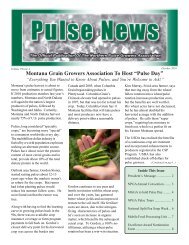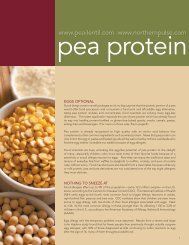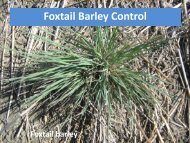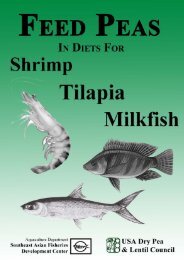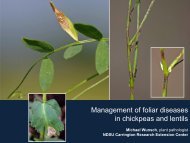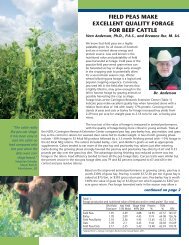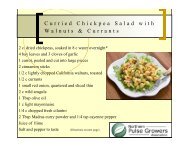Food Applications of Pea Starch - Northern Pulse Growers Association
Food Applications of Pea Starch - Northern Pulse Growers Association
Food Applications of Pea Starch - Northern Pulse Growers Association
You also want an ePaper? Increase the reach of your titles
YUMPU automatically turns print PDFs into web optimized ePapers that Google loves.
NORTHERN CROPS INSTITUTE<br />
<strong>Food</strong> <strong>Applications</strong> <strong>of</strong> <strong>Pea</strong><br />
<strong>Starch</strong><br />
<strong>Northern</strong> <strong>Pulse</strong> <strong>Growers</strong> <strong>Association</strong><br />
6/28/2013
TABLE OF CONTENTS<br />
Frying Batter Experiment ............................................................................................................... 2<br />
<strong>Pea</strong> <strong>Starch</strong> Noodle Experiment ....................................................................................................... 4<br />
Gluten-Free Baking with <strong>Pea</strong> <strong>Starch</strong> Experiment ........................................................................... 6<br />
<strong>Pea</strong> <strong>Starch</strong> as Thickener For Soups and Sauces ............................................................................ 12<br />
Teriyaki Sauce ........................................................................................................................... 12<br />
Mornay Sauce ............................................................................................................................ 13<br />
Dry Chili Mix ............................................................................................................................ 14<br />
Cut Marshmallow.......................................................................................................................... 16<br />
S<strong>of</strong>t Candies Experiment .............................................................................................................. 19<br />
1
FRYING BATTER EXPERIMENT<br />
Objective: To evaluate the functionality <strong>of</strong> pea starch in batter for frying system.<br />
Materials and Methods:<br />
Batter Preparation<br />
Nine treatments varying in the amount <strong>of</strong> wheat flour, corn starch and pea starch were evaluated<br />
(Table 1). The batter was composed <strong>of</strong> 0.85:1 solid to water ratio. Water was kept at 50°F. The<br />
batters were prepared by blending the dry ingredients with water (50°F) and mixed with the<br />
paddle attachment at speed 1 for 30 seconds. The batter was mixed for additional 1.5 min at<br />
speed 5 (Pr<strong>of</strong>essional Kitchen Aid Mixer 6-quart).<br />
Table 1. The solid formulations <strong>of</strong> batter treatments, shown in percentage.<br />
Ingredients 1 2 3 4 5 6 7 8 9<br />
All-purpose flour 95.2 0 0 71.4 71.4 47.6 47.6 23.8 23.8<br />
Corn starch 0 95.2 0 23.8 0 47.6 0 71.4 0<br />
<strong>Pea</strong> starch 0 0 95.2 0 23.8 0 47.6 0 71.4<br />
Salt 2.3 2.3 2.3 2.3 2.3 2.3 2.3 2.3 2.3<br />
Baking powder 1.8 1.8 1.8 1.8 1.8 1.8 1.8 1.8 1.8<br />
Nonfat dry milk 0.8 0.8 0.8 0.8 0.8 0.8 0.8 0.8 0.8<br />
Frying<br />
Samples were deep fat fried at 350°F in commercial bench-top deep fat fryer, containing 2.5<br />
gallon <strong>of</strong> oil. Samples were fried in peanut oil for 9 min.<br />
Analysis <strong>of</strong> samples<br />
The amount <strong>of</strong> batter adhering to the sample during immersion <strong>of</strong> coating prior to frying was<br />
considered as the batter pick up. It was calculated as the weight <strong>of</strong> coating picked up by a nugget,<br />
divided by the weight <strong>of</strong> non-coated nugget times 100. The samples were subjected to an<br />
informal blind sensory evaluation (5 participants). The panel was asked to rate each quality<br />
attribute between 1-9, where 1 being Dislike Extremely, and 9 being Like Extremely.<br />
Results<br />
Results are provided in Table 2. From this preliminary study, we found that pea starch is suitable<br />
for frying batter application. Compared to corn starch, pea starch has slightly better batter<br />
pickup, and provides products with crispier texture. Treatment 5 (3:1 wheat to pea starch) was<br />
rated the overall best product, followed by Treatment 6 (1:1 wheat to corn starch).<br />
2
Products from treatment 1-3 (100% usage <strong>of</strong> wheat flour, corn starch, and pea starch) were<br />
unacceptable. Wheat flour alone did not provide crispiness to the fried fish. Corn and pea starch<br />
did not hold the fish together during frying, and similar problems occurred in treatment 8-9<br />
where the starches were used in high percentage.<br />
In conclusion, pea starch is suitable for batter frying application. When pea starch was<br />
incorporated into the batter, the coating became crispier compared to the corn starch. The<br />
recommended amount is 3:1 wheat to pea starch.<br />
Table 2. Batter pickup and informal sensory evaluation results.<br />
Treatment 1 2 3 4 5 6 7 8 9<br />
Batter pickup (%) 42 11 11 21 24 23 24 12 17<br />
Coating color (1-9) 3.8 7.8 7.8 8.8 8.8 9.0 9.0 8.5 8.8<br />
Coating amount (1-9) 6.5 6.0 6.0 7.3 8.5 9.0 7.5 6.8 6.8<br />
Coating crispness (1-9) 4.0 5.0 5.3 6.3 7.8 8.5 6.5 4.5 6.3<br />
Coating flavor (1-9) 5.5 5.5 6.5 7.0 7.5 7.0 6.8 6.0 6.8<br />
Fish tenderness (1-9) 4.3 4.0 4.3 5.8 7.3 7.3 6.0 3.5 4.3<br />
Fish moistness (1-9) 4.8 3.8 3.8 5.8 7.3 7.5 5.5 3.3 4.3<br />
Fish flavor (1-9) 6.8 5.8 5.3 7.3 7.7 8.0 5.3 4.5 5.3<br />
Overall (1-9) 4.5 4.8 5.0 6.8 7.8 7.3 5.8 4.8 5.5<br />
Figure 1.Treatments <strong>of</strong> fried fish.<br />
1 Wheat flour<br />
4 Wheat/corn 3:1<br />
7 Wheat/pea 1:1<br />
2 Corn starch<br />
5 Wheat/pea 3:1<br />
Wheat/pea<br />
8 Wheat/corn<br />
1:3<br />
3 <strong>Pea</strong> starch<br />
6 Wheat/corn 1:1<br />
3<br />
9 Wheat/pea 1:3
PEA STARCH NOODLE EXPERIMENT<br />
Objective: To understand the functionality <strong>of</strong> pea starch in starch noodle, when compared to<br />
mung bean starch and potato starch.<br />
Materials and Methods: Preliminary experiments were conducted to develop an acceptable<br />
noodle formulation and process. Cooking analysis was conducted on the starch noodles.<br />
Procedures to make the batter:<br />
Table 1. <strong>Starch</strong> noodle batter formulations, shown in gram.<br />
Step 1 Mung bean Potato <strong>Pea</strong><br />
<strong>Starch</strong> 11.25 11.25 11.25<br />
Water 175 140 140<br />
Step 2<br />
<strong>Starch</strong> 238.5 238.5 238.5<br />
Water 174.7 78 174.2<br />
1. Combine starch and water from step 1.<br />
2. Heat the starch mixture until thick and fully gelatinized.<br />
3. Combine the starch from step 2 with step 1 mixture.<br />
4. Mix and slowly add water from step 2.<br />
5. Continue mixing until the right texture is achieved.<br />
*The right texture can be tested by scooping the batter with a spoon. When you drop the<br />
batter, the batter should be sticky enough, and should make a continuous thin stream from the<br />
spoon. The string should not break while streaming. If breaking, the water has to be adjusted.<br />
Procedures to make the noodle:<br />
1. Using a large pot, boil hot water.<br />
2. Put the batter inside the noodle press or squeeze bottle.<br />
*For making the noodle, a noodle press or a squeeze bottle can be used. In this experiment, we<br />
used a squeeze bottle.<br />
3. When the hot water is boiled vigorously, squeeze the batter directly into the water for 15<br />
seconds. Boil the noodle for 30 seconds to 1 min.<br />
4. Soak and wash noodle in cold water for 1 min.<br />
5. Hang noodles and dry overnight at room temperature.<br />
Noodle cooking evaluation:<br />
1. The noodle was cooked until completely s<strong>of</strong>t, and starches completely disappeared from the<br />
core <strong>of</strong> the noodle.<br />
2. The noodles were evaluated for the weight gained after cooking (cooked weight), and loss <strong>of</strong><br />
the water-soluble material to the cooking water (cook loss).<br />
4
Results: The cooking results and pictures <strong>of</strong> the starch noodles are provided in Table 2 and<br />
Figure 1. Mung bean and potato are the traditional source <strong>of</strong> starch use to make Asian starch<br />
noodle (also known as Cellophane noodles, Chinese vermicelli, bean threads, bean thread<br />
noodles, crystal noodles, or glass noodles). The results from this study demonstrated that pea<br />
starch is suitable for making starch noodle. The functionality <strong>of</strong> pea starch noodle is close to<br />
Mung bean starch noodle. Mung bean starch provides firmer texture, slightly longer cooking<br />
time and slightly lower cook loss (Table 2).<br />
Table 2. Results <strong>of</strong> noodle cooking evaluation.<br />
Optimum cooking Mung bean Potato <strong>Pea</strong><br />
Cook time (min) 15.0 13.5 14.5<br />
Water absorption (%) 148.3 256.7 175.7<br />
Cook loss (%) 0.3 5.9 1.1<br />
Overcooking (+5 min)<br />
Cook time (min) 20 18.5 19.5<br />
Water absorption (%) 180 208 229<br />
Cook loss (%) 0.4 14.6 1.2<br />
Figure 1. <strong>Starch</strong> noodles made from pea starch, potato starch, and mung bean starch.<br />
<strong>Pea</strong> starch Potato starch Mung bean starch<br />
5
GLUTEN-FREE BAKING WITH PEA STARCH EXPERIMENT<br />
Objectives: Part 1: To understand if pea starch can be used to replace other gluten-free (GF)<br />
flour in muffin and cookie application, Part 2: To evaluate which kind <strong>of</strong> starch/flour pea starch<br />
can replace in GF muffin and cookie applications, and at what level.<br />
Materials and Methods: Part 1 : This is a preliminary experiment to see whether pea starch can<br />
be used to replace other starch/flour in muffin (Table 1) applications. For this experiment, a GF<br />
muffin recipe was selected. Then, each starch/flour was taken out <strong>of</strong> the recipe and completely<br />
replaced with pea starch.<br />
Table 1. Part 1 formulations <strong>of</strong> GF muffins <strong>of</strong> various treatments, shown in gram.<br />
Ingredients Control<br />
w/o Lentil<br />
flour w/o Rice w/o Potato<br />
w/o<br />
Tapioca<br />
Pregel Lentil Flour 37 0 37 37 37<br />
Rice Flour 25 25 0 25 25<br />
Potato <strong>Starch</strong> 42 42 42 0 42<br />
Tapioca Flour 30 30 30 30 0<br />
<strong>Pea</strong> <strong>Starch</strong> 0 37 25 42 30<br />
Sugar 130 130 130 130 130<br />
Butter 109 109 109 109 109<br />
Eggs (4 Eggs) 100 100 100 100 100<br />
Vanilla 2 2 2 2 2<br />
Heavy Cream 60 60 60 60 60<br />
Baking Powder 4.4 4.4 4.4 4.4 4.4<br />
Salt 0.6 0.6 0.6 0.6 0.6<br />
Part 2: This study looked at the optimal amount <strong>of</strong> pea starch that can be incorporated in GF<br />
muffin and cookie application.<br />
Table 3. Part 2 formulations <strong>of</strong> GF muffin, shown in gram.<br />
Ingredients 1 2 3 4 5<br />
<strong>Pea</strong> <strong>Starch</strong> - 30 60 60 90<br />
Pregel Lentil<br />
Flour<br />
30 30 30 30 30<br />
Rice Flour 30 30 - 30 -<br />
Potato <strong>Starch</strong> 30 30 30 - -<br />
Tapioca <strong>Starch</strong> 30 - - - -<br />
Sugar 130 130 130 130 130<br />
Butter 109 109 109 109 109<br />
Eggs (4 Eggs) 100 100 100 100 100<br />
Heavy Cream 60 60 60 60 60<br />
Baking Powder 4.4 4.4 4.4 4.4 4.4<br />
Salt 0.6 0.6 0.6 0.6 0.6<br />
6
Table 3. Part 2 formulations <strong>of</strong> GF cookies, shown in gram.<br />
Ingredients 1 2 3 4 5<br />
Butter, S<strong>of</strong>tened 149 149 149 149 149<br />
Brown Sugar 98 98 98 98 98<br />
Granulated Sugar 98 98 98 98 98<br />
Egg 100 100 100 100 100<br />
Xanthan Gum 3.3 3.3 3.3 3.3 3.3<br />
Pregel <strong>Pea</strong> Flour 100 100 100 100 100<br />
Rice Flour 60 60 - 60 -<br />
Potato <strong>Starch</strong> 60 60 60 - -<br />
Tapioca <strong>Starch</strong> 30 - - - -<br />
<strong>Pea</strong> <strong>Starch</strong> - 30 90 90 150<br />
Baking Powder 4.7 4.7 4.7 4.7 4.7<br />
Baking Soda 5.4 5.4 5.4 5.4 5.4<br />
Salt 2.8 2.8 2.8 2.8 2.8<br />
Procedures for making GF muffin<br />
1 Make sure that all the ingredients are at room temperature.<br />
2 Using a paddle attachment, cream sugar and butter on speed 8 for 30 seconds,<br />
scrape and mix for 1 min.<br />
3 Scrape the bowl. Add eggs and vanilla. Mix for 2 min on speed 8.<br />
4 Scrape the bowl. Add heavy cream. Mix for 1 min on speed 8.<br />
5 Add flours, baking powder, and salt. Mix at speed 5 for 30 second, scrape, and<br />
mix for 1 min.<br />
6 Fold in chocolate chips.<br />
7 Scoop the dough into a muffin liner. Fill it to the rim. About 74g/ cup.<br />
8 Bake at 370F for 21 min in convection oven.<br />
Procedures for making GF cookies<br />
1 Cream butter and sugar (speed 8 for 30 sec). Add eggs and vanilla and mix at speed 10 for 1<br />
min.<br />
2 Sift together all the dry ingredients. Gradually add the dry ingredients to wet ingredients<br />
(speed 8 for 1 min).<br />
3 Add xanthan gum and mix at speed 8 for 1 min.<br />
4 Drop a spoonful <strong>of</strong> dough onto a greased cookie sheet, about 33-35g.<br />
5 Flatten the top <strong>of</strong> the dough slightly<br />
* The dough spreads very little, flattening is necessary.<br />
6 Bake for 8-10 min at 375F in the convection oven or until light golden brown.<br />
7 Cool on the cookie sheet.<br />
7
Results<br />
Part 1:<br />
There are four different flours in the GF muffin formulation. In part 1, each type <strong>of</strong> flour was<br />
replaced with pea starch and evaluated. We found that there are very slight differences in product<br />
quality when pea starch are used to replace tapioca starch, rice flour, and potato starch, when<br />
compared to the control. The texture <strong>of</strong> the control muffin was the most crumbly. The muffin<br />
with rice flour and potato starch replaced had the best texture (s<strong>of</strong>t, and not crumbly), and<br />
appearance. By replacing all the lentil flour with pea starch, the product was not acceptable.<br />
Figure 1. Side view <strong>of</strong> part 1 treatments.<br />
w/o Tapioca w/o Rice w/o Potato Control w/o lentil flour<br />
Figure 2. Top view <strong>of</strong> part 1 treatments.<br />
Control<br />
w/o lentil flour<br />
w/o Tapioca starch w/o Rice flour w/o Potato<br />
starch<br />
8
Figure 3. Crumb texture <strong>of</strong> part 1 treatments.<br />
Control<br />
w/o Lentil flour<br />
w/o Tapioca starch w/o Rice flour w/o Potato starch<br />
Part 2, GF Muffin:<br />
The levels <strong>of</strong> pea starch that can be used in GF muffin were evaluated. In GF muffin, all<br />
treatments had good flavor. Treatment 2 (replacing tapioca starch) and 4 (replacing both potato<br />
starch and tapioca starch) were very moist and had the best appearance and texture. Treatment 3<br />
(replacing rice flour and tapioca starch) and 5 (rice flour, tapioca starch, and potato starch) had<br />
good flavor, but flat top with light, dry, and crumbly texture. When using high amount <strong>of</strong> any<br />
kind <strong>of</strong> starch in GF muffin, the texture became lighter, more similar to cake texture. From this<br />
experiment, we found that pea starch functions in GF muffin remarkably well and can be used in<br />
place <strong>of</strong> other commonly used GF starches and flours. With this recipe, the recommended<br />
amount <strong>of</strong> pea starch is 56% <strong>of</strong> the total flour.<br />
Figure 4. Side view <strong>of</strong> part 2 GF muffin treatments.<br />
1 2 3 4 5<br />
9
Figure 5. Top view <strong>of</strong> part 2 GF muffin treatments.<br />
1 2 3 4 5<br />
Figure 6. Crumb texture <strong>of</strong> part 2 GF muffin treatments.<br />
1 2 3 4 5<br />
Part 2, cookie:<br />
<strong>Pea</strong> starch was used to replace combinations <strong>of</strong> tapioca starch, rice flour, and potato starch in GF<br />
cookies. All treatments were acceptable and had nice flavor. Treatment 1, 3, and 4 had the best<br />
appearance. Treatment 4 and 5 were noted to have the best flavor. Treatment 3 had the best<br />
overall qualities and the best texture. From this experiment, we found that pea starch is suitable<br />
for replacing tapioca starch, potato starch, and rice flour in GF cookie application.<br />
Figure 7. Crumb texture <strong>of</strong> part 2 cookie treatments.<br />
1 2 3 4 5<br />
10
Figure 8. Top view <strong>of</strong> part 2 GF cookie treatments.<br />
1 2 3 4 5<br />
11
PEA STARCH AS THICKENER FOR SOUPS AND SAUCES<br />
Objective: To evaluate pea starch for soup and sauces applications, and to develop formulations.<br />
Teriyaki sauce<br />
Table 1. Formulation <strong>of</strong> Teriyaki sauce.<br />
Ingredient<br />
Grams<br />
Sauce<br />
Soy sauce 48<br />
Light brown sugar 23<br />
Apple cider vinegar 7<br />
Garlic powder (fine) 0.7<br />
Minced onion 0.7<br />
Worcestershire sauce 0.3<br />
<strong>Starch</strong> mixture<br />
<strong>Pea</strong> starch 3.5<br />
Water 10<br />
Procedure:<br />
1. Combine all the ingredients except starch mixture and heat until boiling<br />
(100 o C), then add well-mixed starch mixture into the sauce and heat for<br />
13 min at temperature around 80-90 o C. Watch the temperature since the<br />
mixture can easily burn.<br />
2. Stir 100g <strong>of</strong> broccoli and 100g <strong>of</strong> chicken (optional) with 1 tbsp <strong>of</strong> oil.<br />
Add sauce and stir for 5 min.<br />
Results and Observations:<br />
Thickness <strong>of</strong> the sauce made with pea starch was found to be higher than the<br />
one made with corn starch. <strong>Pea</strong> starch gelled more than the corn starch when<br />
cooked. The differences remained when the sauce was cooled in the<br />
refrigerator overnight.<br />
The store bought teriyaki sauce is thin and can easily flow while pouring.<br />
The pea starch sauce is much thicker. However, when the pea starch sauce is<br />
used in stir fry, it became thinner. Teriyaki sauce made with pea and corn<br />
starches have the same taste and appearance.<br />
12
Mornay Sauce<br />
Table 2. Mornay sauce formulation.<br />
Ingredients Grams %<br />
Butter, Salted 17.5 6.0<br />
<strong>Pea</strong> <strong>Starch</strong> 10.5 3.6<br />
2% Milk 236 80.3<br />
Salt 1.25 0.4<br />
Black Pepper 0.25 0.1<br />
Nutmeg, ground 0.1 0.0<br />
Shredded 5 Italian<br />
Cheese Blend 28.25 9.6<br />
Procedure:<br />
1. Melt butter in a pan. Do not allow to brown.<br />
2. In a separate bowl whisk together the milk and the pea starch.<br />
3. Add the milk/starch mixture to the butter and whisk constantly.<br />
4. Bring to a boil and cook for an additional 1.5 min.<br />
5. Add the salt, black pepper and nutmeg and stir.<br />
6. Add the cheese and stir in until the cheese has been incorporated.<br />
7. Serve over vegetables or pasta.<br />
Results and observation:<br />
The original Mornay sauce uses wheat flour as the thickener. In this<br />
experiment, pea starch, corn starch and wheat starch were used to<br />
thicken the Mornay sauce and compared. Wheat flour gave the final<br />
product greyish color, the darkest and thinnest among all the<br />
sauces. It was also slightly lumpy. <strong>Pea</strong> starch gave the sauce white<br />
appearance with the thickest consistency. There were no notable<br />
differences in flavor between the three sauces.<br />
After cooling overnight, the sauce thickened with pea starch had<br />
water leeching and seemed thinner than wheat flour sauce. The<br />
sauce thickened with wheat flour had no leeching and appeared<br />
very thick. Upon reheating, there was no major difference in the<br />
texture <strong>of</strong> the pea starch and wheat flour sauces. The corn starch<br />
seemed to be slightly thinner than others. For a sauce covering<br />
vegetables or pasta, a thicker sauce is desirable.<br />
13
Dry Chili Mix<br />
Table 3. Formulation <strong>of</strong> dry chili mix.<br />
Ingredients Gram %<br />
Chili Powder 19.12 6.9<br />
Garlic Powder 6.12 2.2<br />
Onion Powder 4.28 1.5<br />
Oregano, ground 3.05 1.1<br />
Paprika 2.14 0.8<br />
Cumin, ground 6.12 2.2<br />
Thyme, ground 0.61 0.2<br />
Onion, minced, dehydrated 10.36 3.7<br />
Beef Bouillon 20 7.2<br />
Cayenne Pepper 1.84 0.7<br />
Red Beans, dehydrated 43.3 15.6<br />
Pinto Beans, dehydrated 43.3 15.6<br />
Kidney Beans, dehydrated 43.3 15.6<br />
Red & Green Bell Peppers,<br />
dehydrated 22 7.9<br />
<strong>Pea</strong> <strong>Starch</strong> 72 25.9<br />
Total Amount 278.42 100.0<br />
Ingredients to Prepare Chili:<br />
Tomato Sauce<br />
Ground Beef<br />
Water<br />
16 oz<br />
1 lb<br />
6 cups<br />
To Prepare chili:<br />
1. Bring water to a boil<br />
2. Whisk in chili mix, tomato sauce, and cooked ground beef<br />
3. Bring back to a boil.<br />
4. Reduce heat, cover and simmer for 25-30 min, stir occasionally.<br />
14
Results and observations:<br />
<strong>Pea</strong> starch was compared to control (no starch), and corn starch. <strong>Pea</strong> starch provides<br />
thickening effects and consistency similar to corn starch. This experiment concludes that<br />
pea starch can be used as an alternative to corn starch to thicken chili in dry mixes and<br />
similar products.<br />
Table 4. Consistency differences when comparing control, pea starch and corn starch as the<br />
thickening agent in dry chili mix.<br />
Cook Time<br />
(min)<br />
Temperature after<br />
cooking (°C)<br />
Consistency<br />
(cm)<br />
Control (No <strong>Starch</strong>) 25 97.5 12.0<br />
<strong>Pea</strong> (3% pea starch) 25 94.0 7.5<br />
Corn (3% corn starch) 25 95.7 7.5<br />
15
CUT MARSHMALLOW<br />
Objective: To compare the functionality <strong>of</strong> pea starch to the traditional marshmallow<br />
formulation.<br />
Materials and Methods:<br />
Table 1. Formulations <strong>of</strong> cut marshmallow.<br />
Ingredient<br />
Control <strong>Pea</strong> starch<br />
% g % g<br />
Sugar 45.1 316 41.1 288<br />
63/43 DE Corn Syrup 30.0 210 30.0 210<br />
Invert Sugar 4.0 28 4.0 28<br />
Gelatin 1.7 12 1.7 12<br />
Water 18.6 130 18.6 130<br />
<strong>Pea</strong> <strong>Starch</strong> 0.0 0 4.0 28<br />
Vanilla 0.6 4 0.6 4<br />
Total 100.0 700 100.0 700<br />
Table 2. Invert sugar formulation.<br />
Invert sugar<br />
g %<br />
Sugar 76 100<br />
Water 93.25 50<br />
Citric acid 2.5 0.5<br />
Procedure to make invert sugar: Cook until 236 F without stirring. Brush <strong>of</strong>f the crystals on the<br />
side <strong>of</strong> pan using ice water.<br />
Procedure:<br />
1) Control<br />
1. Soak the gelatin in 61 g <strong>of</strong> water and microwave the mixture until clear.<br />
2. Heat sugar, corn syrup and invert sugar and remaining water to 170°F in a pan.<br />
3. Mix the gelatin and sugar solutions.<br />
4. Cool to 110°F and whip the mixture until desired density (around 0.5 g/ml), about 2-3<br />
min.<br />
- To determine density fill souffle cup with water and weigh.<br />
- Fill the same souffle cup with whipped marshmallow and weigh. Divide marshmallow<br />
weight by water weight.<br />
5. Pour mixture on surface or in a pan dusted with corn starch and powder sugar mix.<br />
6. Cool for 2-3 hours and cut.<br />
2) <strong>Pea</strong> <strong>Starch</strong><br />
1. Soak Gelatin as described above.<br />
2. Mix pea starch with sugar, add, invert sugar and corn syrup.<br />
16
3. Heat sugar mixture to 170°F as control and add gelatin mixture.<br />
4. Cool and whip as described above, about 5 min at speed 10.<br />
5. Slab as control in pan with corn starch and powdered sugar mix and cool for 2-3 hours.<br />
Results: From this experiment, we found that both products are very similar (control and pea<br />
starch). <strong>Pea</strong> starch marshmallow requires longer time to whip to the right density. It also exhibits<br />
slightly s<strong>of</strong>ter texture than the control. Apart from this, there is no notable benefit <strong>of</strong> using pea<br />
starch in marshmallow.<br />
Foaming: For pea, foam was s<strong>of</strong>ter and was not as strong as control even though the density was<br />
the same as control (3min). Therefore, it was whipped for longer until foam achieve a the<br />
desirable strength (5 min).<br />
Table 3. Density <strong>of</strong> control and pea foam.<br />
Whipping time (min) Density (g/ml)<br />
Control 3 0.45<br />
<strong>Pea</strong> 3 0.45<br />
<strong>Pea</strong> 5 0.41<br />
Texture analysis: According to the results obtained from the texture analyzer, gumminess,<br />
chewiness, and hardness values were higher in control samples, when compared to the pea starch<br />
samples. With informal sensory panel, both marshmallows were similar.<br />
Table 4. Texture analysis <strong>of</strong> control and pea starch marshmallow.<br />
Hardness<br />
(g)<br />
Adhesiveness<br />
(g.sec)<br />
Resilience<br />
(%)<br />
Cohesion<br />
(%)<br />
Springiness<br />
(%)<br />
Gumminess<br />
(%)<br />
Chewiness<br />
(%)<br />
Control 287.4 -1.3 38.9 0.903 92.1 259.6 239.0<br />
<strong>Pea</strong> starch 203.1 0.9 49.2 0.923 97.7 188.0 184.8<br />
Nutrition: Both control and pea starch marshmallow exhibit similar nutritional content.<br />
No <strong>Pea</strong><br />
<strong>Starch</strong><br />
With <strong>Pea</strong><br />
<strong>Starch</strong><br />
17
Figure 1. Control marshmallow formulation.<br />
Figure 2. Marshmallow containing pea starch formulation.<br />
18
SOFT CANDIES EXPERIMENT<br />
Objective: To evaluate the functionality <strong>of</strong> pea starch in s<strong>of</strong>t candies (gummies).<br />
Materials and Methods:<br />
Table 1. Treatments <strong>of</strong> s<strong>of</strong>t candies.<br />
Treatments 1 2 3 4<br />
Ingredients % g % g % g % g<br />
Corn syrup (62 DE) 30.5 152.5 30.5 152.5 30.5 152.5 15 75<br />
Sucrose 18 90 20 100 18 90 20 100<br />
Corn Syrup (Karo) 0 0 0 0 0 0 15 75<br />
<strong>Pea</strong> starch 0 0 10 50 7.8 39 10 50<br />
Corn starch 7.8 39 0 0 0 0 0 0<br />
Water 43.7 218.5 39.5 197.5 43.7 218.5 40 200<br />
Total 100 500 100 500 100 500 100 500<br />
Flavor<br />
Ingredients<br />
Grams<br />
Citric acid 5<br />
Water 5<br />
Strawberry Flavor 7.5<br />
Procedure:<br />
1. Hydrate starch with partial water and then mix it back with other ingredients.<br />
2. Cook all the ingredients except flavor, citric acid solution (50:50 w:w) to a rolling<br />
boil while stirring vigorously.<br />
3. Once the mixture becomes thickened (at 90 o C), cook for about 5 min or until the mixture<br />
becomes thick and heavy.<br />
* Sugar crystal layer is formed on the bottom <strong>of</strong> pan but do not scrape it as it could<br />
become crunchy in the final product.<br />
4. Cook to an end point <strong>of</strong> 56-58 % solids controlled by a refractometer.<br />
5. To the cooked mixture add flavor and citric acid (50:50 with water) to<br />
taste.<br />
6. Deposit into moulding starch (no more than 7% moisture) and dry at 120-140°F for 8 hours<br />
to reach 81-83% solids.<br />
7. Shake out <strong>of</strong> starch and blow <strong>of</strong>f excess, then pass through steam on a sieve and roll into<br />
sugar.<br />
Note:<br />
*The mixture becomes thickened at around 90°C. However, there is not much change on<br />
temperature after that.<br />
*Initial solid – 49% and end point – 56%.<br />
*Hardness does not change extensively during drying in the oven thus the hardness you<br />
achieve at the end <strong>of</strong> cooking will likely be the hardness <strong>of</strong> the candies.<br />
19
Results:<br />
Figure 1. Comparison <strong>of</strong> 4 treatments <strong>of</strong> s<strong>of</strong>t candies.<br />
1 – Corn<br />
2 – <strong>Pea</strong><br />
3 – High solid with pea starch<br />
4 –50:50 corn syrup 62DE/ Karo with pea starch<br />
Table 2. Result <strong>of</strong> texture evaluation.<br />
Sample Springiness (%) Firmness (g)<br />
1 35.81 4449.42<br />
2 51.64 4012.33<br />
3 57.91 3077.92<br />
4 57.87 4023.76<br />
In order to determine the formulation, pea and corn starches were compared. 1 and 2 had<br />
too much water thus texture <strong>of</strong> candies became too s<strong>of</strong>t. In 3 and 4, percentage <strong>of</strong> solid was<br />
increased. Increasing the solid changed the texture to become tougher and chewy. However,<br />
treatment 3 was too thick to fill the mold since it did not flow. In order to modify the thickness <strong>of</strong><br />
liquid, 50 percent <strong>of</strong> corn syrup was replaced with conventional light corn syrup (Karo) which<br />
has the lower Dextrin Equivalent (DE). By doing so, the end product had good flowing<br />
properties as well as good chewing texture.<br />
Sufficient amount <strong>of</strong> water is necessary in order to gel the starch. This is especially true<br />
for pea starch since their gels are more viscous than corn. However, hardness <strong>of</strong> candies depends<br />
on how much solid is in the formula therefore the amount <strong>of</strong> solid and moisture should be<br />
adjusted in order to achieve the desirable texture. Solid percent in the formulation was modified<br />
to 53% <strong>of</strong> solid since the texture was not hard enough. Cooking time and temperature greatly<br />
affects the chewiness <strong>of</strong> the candy. When the mixture is not cooked enough, the end product after<br />
drying became s<strong>of</strong>t and wet. However, refractometer might not be used as an indicator <strong>of</strong> ideal<br />
cooking time due to starch gelatinization. The Brix % does not directly reflect the amount <strong>of</strong><br />
solid because water is trapped in the starch. Therefore, the cooking time should be determined<br />
based on thickness <strong>of</strong> the mixture and time. In addition, sugar tends to get crystalized and form a<br />
layer in the bottom <strong>of</strong> the pan when candies are made on the stove top. This could cause crunchy<br />
bits in the products. Using non-sticky pan and avoid scraping the bottom while stirring could<br />
20
help avoiding the problem. Also heat should be lowered once the mixture is thickened to avoid<br />
burning on bottom. Nevertheless, pea starch works well in s<strong>of</strong>t candy application, and would<br />
make better product over corn starch due to higher gelling property which could provide better<br />
chewy texture. Recommended s<strong>of</strong>t candy formulation using pea starch is shown in Table 3.<br />
<strong>Pea</strong> <strong>Starch</strong><br />
Corn <strong>Starch</strong><br />
Table 3. Recommended candy formulation with pea starch.<br />
Ingredients % g Solid (%)<br />
Corn syrup (62DE) 15.0 75.0 80.0<br />
Corn syrup (Karo) 15.0 75.0 80.0<br />
Sucrose 20.0 100.0 99.0<br />
<strong>Pea</strong> starch 10.0 50.0 93.0<br />
Water 40.0 200.0 0.0<br />
Total 100.0 500.0 352.0<br />
Flavoring<br />
Ingredients<br />
Grams<br />
Citric acid 5<br />
Water 5<br />
Strawberry Flavor 7.5<br />
21




